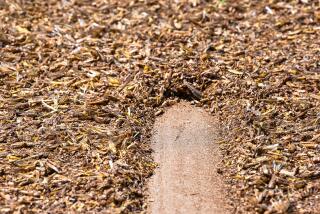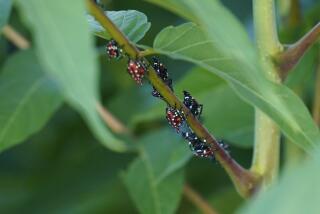A Carpet of Crickets in the West
- Share via
ELK SPRINGS, Colo. — Millions of ravenous crickets, moving like an ancient plague, are on the march across vast swaths of the West, chewing up everything in their path and leaving a trail of destruction. In cities and towns, on ranches and farms, the brazen bugs have shown up like unwanted dinner guests who would just as soon eat the napkins as the main course.
Traveling in hordes that can measure a mile wide and three miles deep, their wriggling bodies easily carpet streets and highways. The crickets sometimes climb the sides of houses to escape the heat, giving homes an eerie, quivering quality.
Officials say a succession of mild winters and drought conditions have combined to create the worst Mormon cricket infestation in 60 years, one that is destroying crops and giving plenty of residents the creeps.
So far Utah has been hardest-hit with $25 million in damage. Nevada has also been besieged with crickets, spending $350,000 to contain the onslaught in its worst-hit county. Officials in Idaho, Colorado and Wyoming are still determining their cricket costs.
“They come in droves, in herds,” said an astonished George Bosick, a ranch manager in this tiny town about 260 miles west of Denver. “The whole road turns purple. I tell people they have to see it to believe it.”
And it’s not hard to see it.
Just a mile from his house, hundreds of thousands of 2-inch-long crickets, which can travel a mile per day, flood the highways as they crawl eastward toward the rolling open rangelands. The roads appear alive with squirming legs and twitching antennae. Undeterred by speeding cars that pop them like bubble wrap, the stoic crickets simply cannibalize their dead and keep on moving.
“This is the worst I have ever seen,” said Bruce Johnson, pest control manager for Moffat County in northwest Colorado. “We have had three or four years of easy winters and droughts. There has been a massive buildup of eggs and they have all hatched.”
Johnson said the crickets are destroying the hay meadows. In some areas, they number 150 per square yard.
Grasshoppers have also caused major problems this year. Though not as migratory or numerous as the crickets, the grasshoppers are considered by entomologists even more destructive because they breed more often and eat until a crop is decimated.
“It’s horrible,” said Tom Mikesell, who manages the 21,000-acre Monument Butte Ranch in Hamilton, a small Moffat County town where grasshoppers are methodically destroying the alfalfa crop. “We’ve had grasshoppers before but nothing like this.”
Mikesell said drivers on the ranch sometimes need windshield wipers to see through the clouds of leaping insects. Alfalfa that once grew to the road now has been eaten 3 feet back.
“The other day, the ground was moving with grasshoppers,” he said, pointing to emerald-green fields stretching to the jagged mountains. “They’re worse than crickets -- crickets devour and move but grasshoppers stick around until everything is all gone.”
In Idaho, where 515,000 acres are infested, signs have gone up on the highways warning motorists to drive carefully over dead crickets.
“Add a little water to cricket guts and it’s like an oil slick,” said Julie Pipal of the Idaho State Department of Agriculture.
The situation is worst in Utah, where 29 counties are infested and sand is being spread on roads to give cars traction over crushed bugs.
“We are estimating $25 million in crop loss so far,” said Larry Lewis, spokesman for the Utah Department of Agriculture. “One cricket can consume 38 pounds in their lifetime and they live from about March to July.”
The wingless crickets, actually a form of katydid, got their name in 1848 when Mormon farmers were besieged by the bugs and prayed for deliverance. According to the story, seagulls arrived en masse from the Great Salt Lake, rescuing the farmers by eating all the crickets.
These days, however, Salt Lake seagulls prefer dining in a nearby landfill, leaving farmers to fend for themselves.
“In the last three years, the crickets have become quite aggressive to the point where communities are inundated with them. It becomes a psychological problem for people,” Lewis said.
“People don’t like walking in their driveways because they hate squishing them. Their numbers are sometimes so great they cover the sides of houses and it looks like the whole house is moving.”
This month, Elko County, Nev., declared a state of emergency because of its crickets.
“They got into the mall, one store was packed with them,” said John Ellison, an Elko County commissioner. “Our buildings and roads were covered with them. One local police officer was at a fire and saw what he thought was water running toward him but it was, in fact, crickets.”
Ellison said the county took aggressive measures with poison bait and spraying and has, at least temporarily, stemmed the tide.
“We will be ready next year,” he said. “We have maps and we are tracking them to make sure we are not surprised again.”
It’s just as well, because the female crickets are already laying their eggs -- up to 120 each -- and if this is another mild winter, next year could see an even bigger outbreak. Complicating things further, the eggs are laid underground, making it extremely difficult to find and destroy them. The best bet, say scientists, is to kill the crickets when they emerge from the ground.
Jeff Knight, an entomologist for the Nevada Department of Agriculture, said spraying insecticide from the air and ground baiting have been effective in killing crickets.
“These high cricket years can go for 18 years in a row but we are getting the numbers down,” he said. “There is nothing we can do about the eggs that were laid, except record where they are and keep track of them when it warms up.”
Knight said the worst cricket infestations this year have been in Nevada and Utah but that the insects are also present in parts of eastern California, Idaho, Colorado, New Mexico, Nebraska, Wyoming and Arizona.
“They will basically eat anything,” he said. “They will chew through screens and nibble on houses.”
In Moffat County, some residents feel under attack by an invading army.
“There is nothing you can do, they come in such large numbers,” said Paul Gowdy, who raises pheasants in Maybell. “You can’t take a shovel and kill thousands of them. All you can do is look on helplessly.”
Tom Lefevre said the crickets had come up to the gates of his farm before turning and heading in another direction.
“It seems that sometimes they eat, get full and just keep on walking past,” he said. “Let’s hope they stay full.”
Bruce Johnson, the county pest control manager, is baiting fields with cricket and grasshopper poison. Aerial spraying will begin shortly as columns of insects head relentlessly eastward.
“If we don’t stop them,” warned a weary Johnson, “they are going to destroy all of our crops.”
More to Read
Sign up for Essential California
The most important California stories and recommendations in your inbox every morning.
You may occasionally receive promotional content from the Los Angeles Times.













